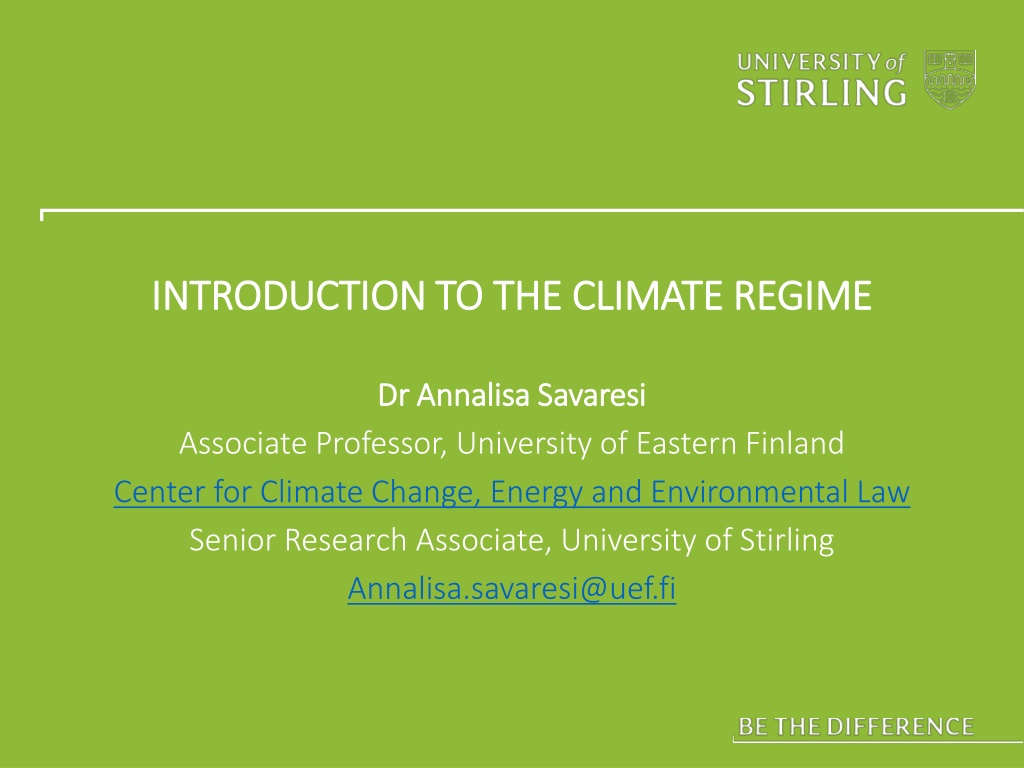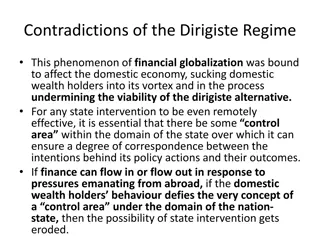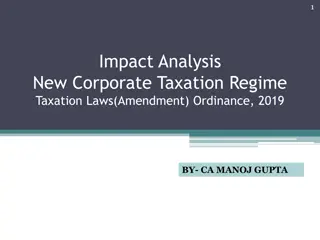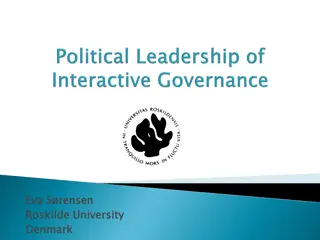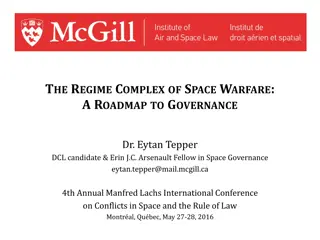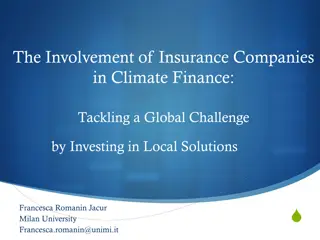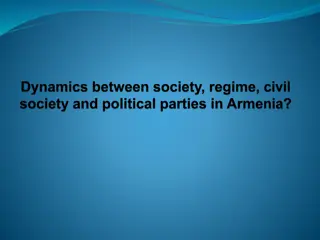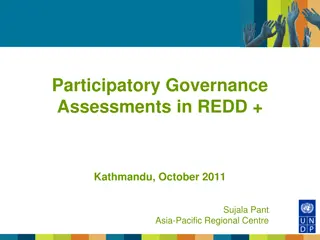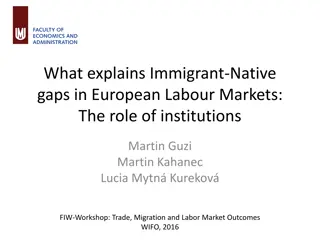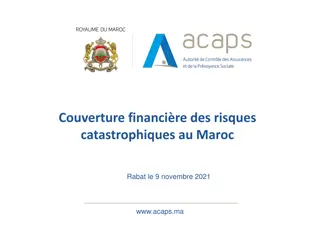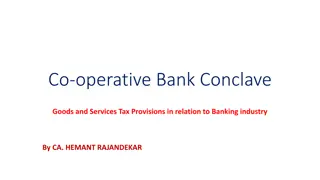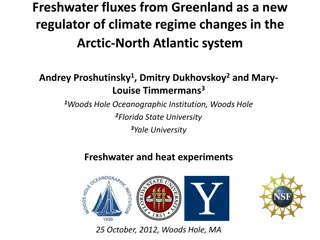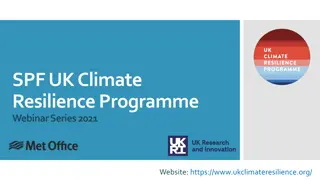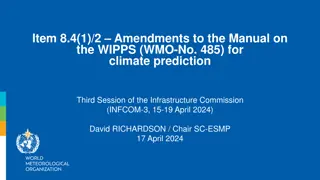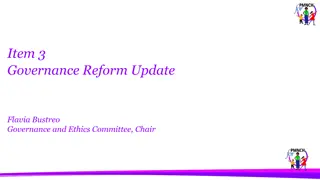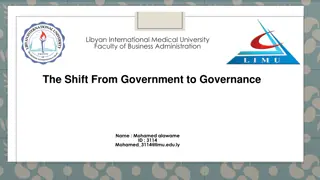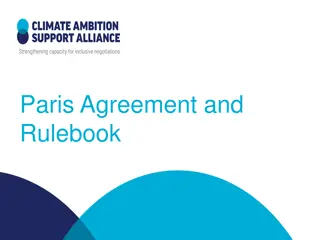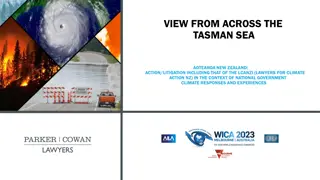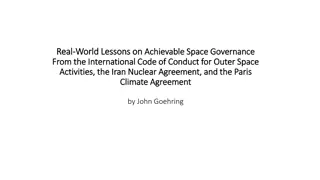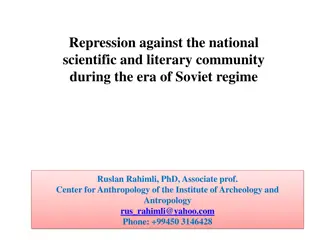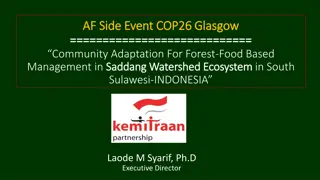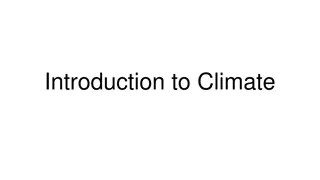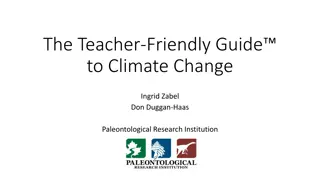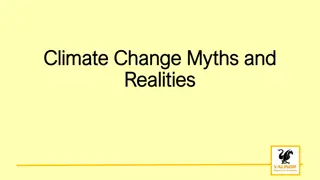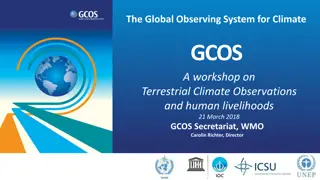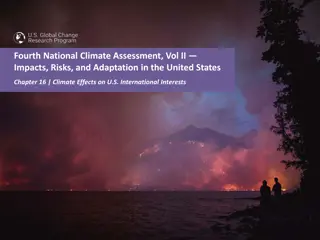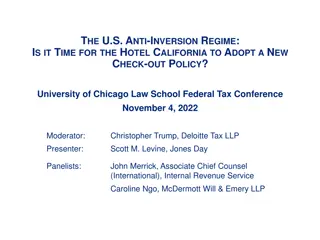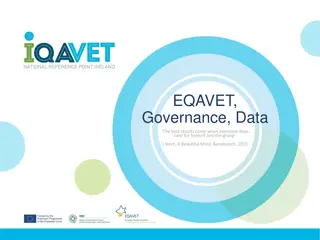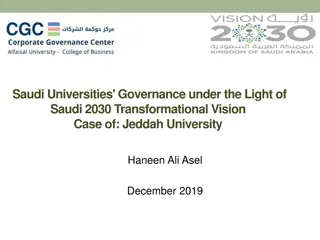Understanding the International Climate Regime and Governance
In this comprehensive overview, Dr. Annalisa Savaresi delves into the intricacies of the international climate regime, highlighting key aspects such as international climate law, major climate conferences like COP26, and the evolution of climate governance. The discussion covers important agreements like the Paris Agreement and the Kyoto Protocol, emphasizing the need for global cooperation and coordination to address climate change effectively.
Uploaded on Oct 06, 2024 | 0 Views
Download Presentation

Please find below an Image/Link to download the presentation.
The content on the website is provided AS IS for your information and personal use only. It may not be sold, licensed, or shared on other websites without obtaining consent from the author. Download presentation by click this link. If you encounter any issues during the download, it is possible that the publisher has removed the file from their server.
E N D
Presentation Transcript
INTRODUCTION TO THE CLIMATE REGIME INTRODUCTION TO THE CLIMATE REGIME Dr Annalisa Savaresi Dr Annalisa Savaresi Associate Professor, University of Eastern Finland Center for Climate Change, Energy and Environmental Law Senior Research Associate, University of Stirling Annalisa.savaresi@uef.fi
Summary Summary International climate law International climate conferences COP26: what s on the agenda?
INTERNATIONAL CLIMATE LAW INTERNATIONAL CLIMATE LAW
International law on climate International law on climate change change Paris Agreement, 2015 Kyoto Protocol, 1997 UN Framework Convention on Climate Change, 1992 International cooperation and coordination to address the climate change
The functions of climate change The functions of climate change treaties treaties Establishing mechanisms and procedures for adopting rules, settling disputes and supervising implementation and compliance Constitutional Setting rules for international cooperation and coordination to prevent/reduce climate change and for grappling with its impacts Regulation Setting homogenous practices across jurisdictions to report emissions and emission reduction activities Harmonisation
Constitutional function Constitutional function www.unfccc.int
Regulatory function Regulatory function Technology Information Finance Mitigation, adaptation
Why is it so difficult? Why is it so difficult? Historical responsibility Political feasibility
Evolution in international climate Evolution in international climate governance governance Top down Obligations of conduct (means) Obligations of result Bottom up Savaresi A, The Paris Agreement: Reflections on an International Law Odyssey (2019) <https://ssrn.com/abstract=2912001 >
Paris Agreement: Core elements Paris Agreement: Core elements Transpa- rency Mitigation Review of implementation Global Goal Nationally Determined Contributions Review of effectiveness Leveling parties obligations Review of compliance
Paris Agreement: Core elements Adapt- ation Loss and damage Human displacement Global goal National Adaptation Plans compensation
A comparison with earlier climate treaties With the UNFCCC With the Kyoto Protocol The Paris Agreement is a a great levellerof Parties obligations, most saliently in relation to mitigation and the provision of information. Diminished legal force of Parties mitigation obligations was a trade off for the universal commitment to emission reductions, and the creation of a unitary system for the review of implementation, compliance and effectiveness.
The Paris Agreements story so far The Paris Agreement s story so far Adoption December 2015 Opened for signature April 2016 Entry into force November 2016 Implementation Guidelines December 2018 Implementation by 2020
INTERNATIONAL CLIMATE INTERNATIONAL CLIMATE CONFERENCES CONFERENCES
The conferences of the parties (COP) The conferences of the parties (COP) aka United Nations climate change conferences United Nations climate change conferences aka COPs take place yearly since 1995 and rotate annually between the five UN regional groups COPs are amongst the world s largest diplomatic gatherings COPs attract thousands of civil servants and state representatives (50%), as well as civil society (50%)
The functions of COPs The functions of COPs To review the implementation of the climate treaties To adopt decisions to further develop and implement the obligations enshrined in these treaties CONSENSUS-BASED DECISION-MAKING!
Not all COPs are the same.. Not all COPs are the same.. Treaty-making COPs Rule-making COPs COP21 Paris 2015 COP26 Glasgow 2021 COP24 Kato- wice 2018 COP15 Copen- hagen 2009 COP7 Marra- kesh 2001 COP3 Kyoto 1997 COP6 The Hague 2000
Who does what at COP Who does what at COP The Secretariat The COP Presidency Political leadership role at the service of the process Technical/non- political role at the service of parties UNFCCC Secretariat approx 450 international civil servants Department for Business, Energy and Industrial Strategy
Some examples Some examples COP21 Paris, 2015 COP16 Cancun, 2010
Not all climate conferences end Not all climate conferences end well well COP15, Copenhagen 2009 COP25, Madrid 2019
THE PARIS AGREEMENTS THE PARIS AGREEMENT S ACCOUNTABILITY GAP ACCOUNTABILITY GAP
COP26: WHATS ON THE AGENDA? COP26: WHAT S ON THE AGENDA?
A little more on the Paris A little more on the Paris Agreement Agreement Transpa- rency Mitigation Review of implementation Global Goal Nationally Determined Contributions Review of effectiveness Leveling parties obligations Review of compliance
The Paris rulebook what remains to be done Article 6 Article 13 Transparency framework Internationally transferred mitigation outcomes aka carbon markets Transition towards common rules on Accounting of emissions Reporting on progress in the achievement of NDCs Review of institutional arrangements Transition away from old KP rules Institutional arrangements Environmental integrity Double-counting Outcomes of COP25 GNHRE Webinar
What else is on the agenda? Communication of new/revised NDCs Publication of long-term strategies to 2050 for all parties Source: UNEP Gap report 2019
The road from The road from Glasgow Glasgow The road to Glasgow Subsidiary bodies meeting June 2021 COP27 Egypt New NDCs 2025 Stock-take 2023 Balance between emissions and removals 2050 Pre-COP Italy Sept/Oct 2021
Whatever works! The The measure measure of of success success The limits of international cooperation The importance of national action and of sustained political will at the national level
